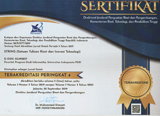Analisis Cluster K-Means pada Indikator Indeks Pembangunan Teknologi, Informasi, dan Komunikasi
(1)
(2) Universitas Indraprasta PGRI
(3) Universitas Indraprasta PGRI
(*) Corresponding Author
Abstract
The information and Communication Technology Development Index (IP-ICT) is used to describe the level of ICT Development, the imbalance and development opportunities of a region from the use of ICT. IP-TIK is composed of 11 indicators, with the calculation conducted by BPS. The analysis is a K-Means Cluster analysis used to group provinces in Indonesia based on the similarity of IP-ICT constituent indicators. Grouping provinces based on IP-TIK indicators will help the government set realistic targets, track and evaluate progress over time to promote development and growth based on the capabilities of each province, so that the government is able to determine the right policies to assist in ICT development in each cluster. The results of this study obtained 4 clusters with different characteristics each. Cluster 1 and Cluster 2 require improvement in IP-TIK development.
Keywords
Full Text:
PDFReferences
J. Kimani and J. Scott, Information Communication Technology Diploma Level, USA: Finstock Evarsity Publisher, 2023.
International Technology Union (ITU), Measuring The Information Society The ICT Development Index. Geneva (CH): International Technology Union, 2018.
Badan Pusat Statistik, Indeks Pembangunan Teknologi Informasi dan Komunikasi (ICT Development Index) 2018. Jakarta (ID): Badan Pusat Statistik, 2019.
Khoirunnisa dan W. Budiarti, “Pengaruh TIK terhadap Tingkat Kemiskinan di Indonesia Tahun 2012-2017”. Jakarta : Politeknik Statistika Jakarta, 2019.
M.W Talakua, Z.A. Leleury, dan A.W. Talluta, “Analisis Cluster dengan Menggunakan Metode K-Means untuk Pengelompokkan Kabupaten/Kota di Provinsi Maluku Berdasarkan Indikator Indeks Pembangunan Manusia Tahun 2014”, Jurnal Ilmu Matematika dan Terapan, vol.11, No.2, pp. 119-128, Ambon : Universitas Pattimura, 2017.
R. Scitovski., et all, Cluster Analysis and Applications. Switzerland : Springer Cham, 2021.
B. Sartono, D. K. Bodro dan G. A. Ditto, Teknik Eksplorasi Data yang Harus Dikuasai Data Scientist. Bogor : PT. Penerbit IPB Press, 2021.
M. Nishom dan M.Y. Fathoni, “Implementasi Pendekatan Rule-Of-Thumb untuk Optimasi Algoritma K-Means Clustering”, Jurnal Informatika: Jurnal Pengembangan IT, vol.3, No.2, pp. 237-241, 2018.
T.M. Kodinariya dan P.R. Makwana, “Review on Determining number of Cluster in K-means Clustering”, International Journal of Advance Research in Computer Science and Management Studies, vol. 1, no. 6, pp. 90-95, 2013.
M. Nishom, “Perbandingan Akurasi Euclidean Distance, Minkowski Distance, dan Manhattan Distance Pada Algoritma K-means Clustering Berbasis Chi-square", Jurnal Informatika: Jurnal Pengembangan IT, vol.4, no.1, pp. 20-24, Tegal : Politeknik Harapan Bersama, 2019.
DOI: http://dx.doi.org/10.30998/string.v8i2.16638
Refbacks
- There are currently no refbacks.
Copyright (c) 2023 ZUHANA REALITA ALFY

This work is licensed under a Creative Commons Attribution 4.0 International License.
STRING (Satuan Tulisan Riset dan Inovasi Teknologi) indexed by:

Ciptaan disebarluaskan di bawah Lisensi Creative Commons Atribusi 4.0 Internasional.
View My Stats


 Sertifikat Akreditasi
Sertifikat Akreditasi
















